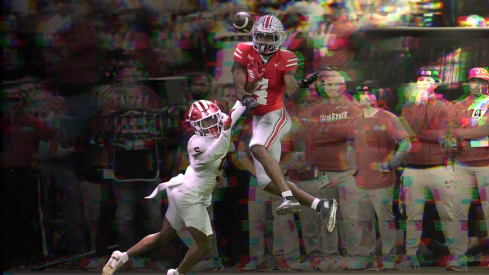
An erratic opening offensive game plan and miscues helped stick Ohio State in a 17-0 hole. The Buckeye offense got on track once Braxton Miller began making plays – often out of nothing – but in the end the Buckeyes fell short.
Ohio State's late game struggles resulted from a failure to capitalize on potential opportunities. An inconsistent passing game too often left the offense behind schedule, and potential yards were left on the field through poor execution.
The Spartans did not shut down what Ohio State does well. But Pat Narduzzi's defense won against the Buckeye offense's relative weakness; its wide receivers and the Buckeye passing game.
In hindsight, the Buckeyes probably should have stuck with its inside run game until Michigan State stopped it. But it remains the case that the Buckeyes had opportunities down field and did not capitalize.
Below I examine Michigan State's defensive strategy, the Buckeyes' response, and how Michigan State won on the edge.
This is what we do
Michigan State's defense operated exactly how one would expect. The Spartans played their base 4-3 over, cover 4. Their safeties were often no more than seven yards off the line of scrimmage, and Narduzzi generally cheated his nickel/sam linebacker off the slot receiver into the box.

To compensate for leaving the slot receiver uncovered, the Spartans would, at times, roll a safety down at the snap to cover the slot and play cover 1, In so doing, the Spartans hoped to prevent Ohio State from automatically throwing wide receiver screens to uncovered receivers.
Following the snap Michigan State blitzed frequently, particularly on third down, The Spartans employed their trademark double-A gap cross dog, but also utilized field side pressure.
Pushing the Edge
The Buckeyes opened by attacking the weaknesses in the Spartan scheme, namely the in the flats and over the top. Urban Meyer and Tom Herman's goal was to loosen up the Spartan safeties.
Unfortunately, Ohio State made little hay doing so. For instance, Herman dialed up swing routes to Carlos Hyde for little or no gain. And the Buckeyes had deep opportunities, but critical drops – such as the one by Corey Brown – prevented explosive plays.
Ohio State's offense only got on track in the second quarter once Miller scrambled off designed pass plays.

Michigan State's blitzing, in combination with man coverage, left wide swaths of field open for Miller, with no Spartans to react because their backs were turned in pass coverage. It was a risky strategy by Michigan State, given Miller's running ability. And, in fact, Miller left further opportunities on the field by staying in the pocket too long. He took sacks and/or threw balls away where, if he was more willing to tuck and run, he could have gathered positive yardage.
Hitting their Stride ... For a Moment
Miller hitting several big runs got the Buckeye offense going. Ohio State began having success with Hyde and Miller on designed runs, as well as hitting several critical play action passes.
As soon as the Buckeyes grabbed the lead, however, the offense again became stuck in neutral. The relative inefficiency of the Buckeye passing game caught up with Ohio State. The Buckeyes were only four of 13 throwing on first down. This led to a night of the Ohio State offense finding itself behind schedule. This had a multiplier effect, making it even harder for Ohio State to rely upon their running game when it was second or third and long.
The inconsistent passing game had multiple culprits. As has all too often been the case this season, the Ohio State passing game become overly reliant on throwing vertically. It is difficult to determine if it is a function of the play calling, if the play calling is trending towards such routes because those are the only ones where the receivers are getting open, or if Miller is throwing deep even when mid-range routes in the pattern are available. Whatever the case, all too often the Buckeyes missed long, only to leave themselves in second and ten.
Miller himself was inconsistent. He made some nice throws, but also missed several open receivers – particularly on the sidelines – and did not attempt to fit the ball into tight windows, except on rare occasions, like the touchdown he tossed to Brown in the second quarter. As mentioned, he also held the ball too long when he could have picked up yards scrambling.
But the Buckeye wide receivers were as, if not more, culpable. All season, my belief was that the primary way a good defense could slow the Ohio State offense was use man coverage against the Buckeye wide receivers, who have not demonstrated an ability to get separation. And, with the possible exception of Brown, Ohio State's receivers struggled to get open all game against the Spartan secondary. Buckeye receivers did not win contested balls and worse, when they were open, they made several drops, none more harmful than Evan Spencer's on third down.
Miller thus did not receive any help from his receiving corps, and, as noted, it is possible that a reduction in the pass patterns called resulted from a lack of confidence in this unit. It is also not coincidental that Miller's late season accuracy swoon coincided with Brown's stress fracture.
Winning Strength vs. Strength
Making the passing game inefficiency worse, even with the Spartans' aggressive strategy the Buckeyes rushed for 7.67 yards per attempt on first down. In hindsight, Meyer and Herman should have stuck with the run until the Spartans stopped it. Instead, the Buckeyes threw on first down almost as much as they ran (13 passes versus 17 runs). Even assuming those 13 throws include two spikes in the two minute drill, it remained a sub-optimal breakdown given the Buckeyes' strength rushing the football.
In fact, the Buckeyes would have likely gained more yards on the ground if Miller was more consistent in his reads. Particularly noticeable were several inverted veers where Miller kept when he should have handed off, the most critical being on third and four in the fourth quarter, where if Miller gives to Jordan Hall he still may be running.
Carlos Hyde was thus underutilized despite a fairly efficient performance. The offense's first series is emblematic of the entire game. On first down, Hyde ran for six yards. On second down, Herman dialed up a swing route to Hyde that was limited to a two yard gain. Then in third and short, Corey Linsley snapped the ball prior to Miller being ready, leading to a blown play. Ohio State thus went from second and medium to a harmful three and out. And the series reflected the Buckeyes' unwillingness to consistently rely upon their inside run game.
In so doing, Meyer and Herman seemingly got stuck in a no-man's land of play calling. On the one hand, they wanted to throw the football against the Spartans' aggressive strategy, but they did not fully trust the passing game. The Buckeye offense thus threw fairly frequently, but frequently did so with low percentage vertical routes. If they did not trust their passing game, they may have been better served by going all in on the run game with Hyde and Miller.
Dancing with the One that Brung 'Ya
Building upon that, many will second guess the fourth quarter, fourth down lead outside zone with Miller.

But Meyer succinctly explained his reason for the call.
Yeah, it was my call. I wanted to put the ball in the hands of our best player, Braxton (Miller). We usually run that play a lot. We ran it to the boundary. I knew they'd pressure us. Thought he might be able to come out the other end of it.
I believe this was the correct strategy. Despite the miscues described above, Ohio State is not in that game (or 24-0) without Miller's running ability. He is perhaps the most dynamic runner in college football and ran the ball effectively all Saturday. So it made sense to put the football in his hands. Plus, the play was one Jeff Heuerman missed reach block from being a big gain.
To me, the more problematic call was the previous play, that being the third down quarterback counter trey. Again, I do not see a problem running Miller. But by going empty and splitting Hyde wide, it eliminated a thread that Michigan State had to concern itself with and telegraphed the play call.
The Back Got too Sore
Although the Ohio State offense undoubtedly failed in not scoring after a recovered onside kick, interception, and punt block, blame directed towards the offense can only go so far. All year, the Buckeye offense carried the defense. Yet the moment the offense needed the defense to get a stop the defense could not do so.
The reality is that this team was always going to rise and fall with its offense, which perhaps showed the ceiling for the 2013 Buckeyes. But the fact remains that the offense's inability to convert in critical situations doomed Ohio State's chances of winning.

